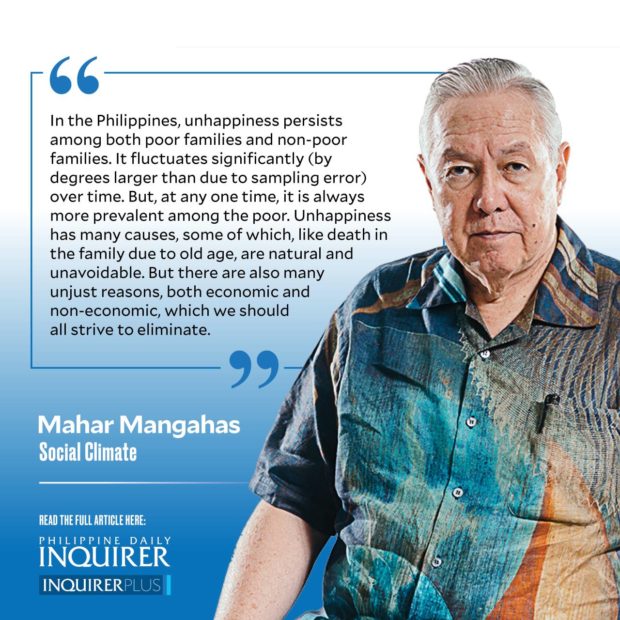The happiness measurement biz
The measurement of happiness is a regular activity in quality-of-life research. There is a World Database of Happiness (WDH) and a Journal of Happiness Studies (JHS); Professor Ruut Veenhoven of Erasmus University, Netherlands, WDH founder and JHS’ first editor, is known as the “pope of happiness.” There is an annual World Happiness Report, based on the Gallup World Poll. Bhutan is a singular country that proclaims gross national happiness as its national goal.
In the Philippines, SWS has two general questions for “happiness” in its surveys of adults. The first is: “Thinking of your life as a whole these days, would you say you are VERY HAPPY, SOMEWHAT HAPPY, NOT VERY HAPPY, or NOT AT ALL HAPPY?” In Filipino, the four choices of answer are: TALAGANG MASAYA, MEDYO MASAYA, HINDI MASYADONG MASAYA, and TALAGANG HINDI MASAYA. Let’s call this the H question, H for happiness; bear in mind that the answers are part of the question.
Article continues after this advertisementThe second SWS general probe is: “All in all, are you VERY SATISFIED, SOMEWHAT SATISFIED, NOT SATISFIED, or NOT AT ALL SATISFIED, with your present life?” In Filipino, the answers are LUBOS NA NASISIYAHAN, MEDYO NASISIYAHAN, HINDI NASISIYAHAN, and LUBOS NA HINDI NASISIYAHAN? Let’s call this the LS, or life-satisfaction question.
The H and the LS questions are both popular in subjective well-being research. Although their four answers could be encoded 4, 3, 2, and 1 in the computations, they do not mean that the first answer is four times as intense as the last answer. Their interpretation is up to the data user.
I prefer questions with answers individually described in clear words to those which ask for a number on a scale of, say, 0 to 10 where 0 means, for example, the worst possible life the respondent can imagine, and 10 means the best possible life the respondent can imagine, and the other numbers just mean something, whatever, in-between. This type of question—which I call the “Miss Universe” question, as though countries are competing in terms of happiness—is used in the World Happiness Report.
Article continues after this advertisementIn over 40 SWS national surveys using the H and LS probes, the most popular answer has been the second one, “somewhat happy/satisfied,” with percentages usually in the 40s and occasionally in the 50s. I see it as the “default” response of Filipinos. The answer “happy” is slightly more popular than “satisfied with life.” There is no seasonality, as far as I can see.
For time-charts, see “First Quarter 2019 Social Weather Survey: 44% of Pinoys are ‘Very Happy’ with life; 37% are ‘Very Satisfied’ with life,” www.sws.org.ph, 6/3/2019. SWS paused its happiness-tracking in 2020, the first pandemic year, and resumed in 2021; it will issue an update soon, up to 2022.
To me, the first answer to the H and LS questions measures gross happiness, while the third and fourth answers, added up, measure gross unhappiness, to which I am partial (“Unhappiness matters more,” Inquirer.net, 8/7/21).
Filipino unhappiness has almost always been double-digit; it exceeded 20 percent several times, even before the pandemic. Unhappiness fluctuates over time, both upwards and downwards, with its main driver clearly being economic deprivation (see my “Unhappiness, life-dissatisfaction and economic deprivation in the Philippines: three decades of survey history,” in “The Pope of Happiness: A Festschrift for Ruut Veenhoven,” Springer, 2021).
In the Philippines, unhappiness persists among both poor families and non-poor families. It fluctuates significantly (by degrees larger than due to sampling error) over time. But, at any one time, it is always more prevalent among the poor.
Likewise, there is always some unhappiness among both hungry and non-hungry families. Yet, at any one time, it is always worst among the severely hungry, followed by the moderately hungry. And it is least among the non-hungry, for whom it must have come about for other reasons.
Unhappiness has many causes, some of which, like death in the family due to old age, are natural and unavoidable. But there are also many unjust reasons, both economic and non-economic, which we should all strive to eliminate.
——————
Contact: mahar.mangahas@sws.org.ph

















